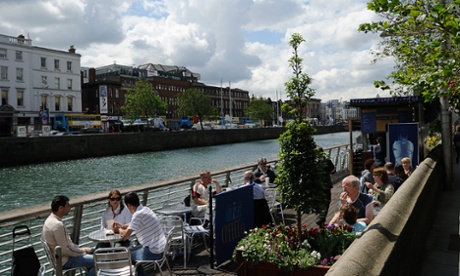
Ireland’s economy is “starting to fire on all cylinders”, but the scars of the crisis are still visible in high unemployment, widespread mortgage arrears and house prices 38% below their peak, according to a new report by the International Monetary Fund.
In its annual assessment of the Irish economy, known as an Article IV, the IMF charts the country’s successful emergence from the deep recession of 2008 and 2009. Irish economic growth is expected to be a healthy 3.5% in 2015, slowing to 3% next year, much of it led by exports.
“Ireland’s recovery is off to a good start in 2013–14, with some of the adverse legacies from the crisis beginning to heal,” the IMF finds.
Unemployment has fallen from a peak of 15% to 10%, but remains well above the pre-crisis level of 4.5%. House prices have bounced back, rising at 16% a year, as fast as during the boom, but they are still 38% below the dizzy heights of 2008.
After more than five years of spending cuts, the deficit on public finances should hit 3% of GDP in 2015, the IMF predicts, which would allow the country to leave the EU’s “excessive deficit procedure”.
While Dublin was subject to the strictures of the “troika” of the IMF, the European Commission and the European Central Bank, which oversaw its €67.5bn bailout loan, its creditors were often accused of driving it into austerity.
The IMF, however, uses its report to urge Dublin to be cautious about the pace of future spending cuts, lest it choke off growth. It argues for a “phased and steady adjustment, allowing a continued build-up of the fiscal space while supporting the recovery in the near term.” The government left the bailout programme in late 2013.
Irish consumers have also worked hard to pay down their debts, mainly by slashing their savings ratio, the share of their income they put aside for a rainy day. Almost 15% of mortgage borrowers are still in arrears; however, and the average household has debt worth 177% of its annual income – very high by both historical and international standards.
The IMF cheers Ireland’s strong record of growth since it emerged from its international bailout in 2013, but points to the significant role of “contracted manufacturing”, under which multinationals score production in Ireland for tax purposes even though the goods may never cross the Irish border. The practice may have added as much as two percentage points to GDP in the first three quarters of 2014 alone, the IMF calculates.
Dublin insisted on maintaining its 12.5% corporation tax rate, unusually low by international standards, throughout the crisis negotiations with its international creditors.







